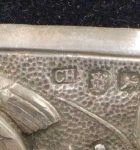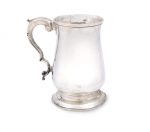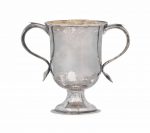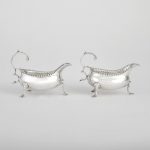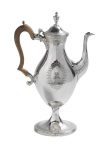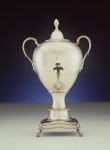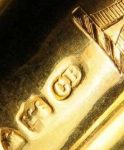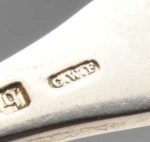Charles Hougham was a silversmith between 1769-1793. He was the brother of Solomon Hougham, another prominent silversmith of the time.
Charles Hougham Silver Makers Mark
A George III silver mug possibly by Charles Hougham, London 1780 Of plain conventional form with a leaf capped scroll handle, height 12.5cm, weight 9oz.
Sold for £ 350 inc. premium at Bonhams in 2015
A GEORGE III SILVER TWO-HANDLED CUP MARK OF CHARLES HOUGHAM, LONDON, 1783 With gilt interior; together with an early George III silver sauceboat, London, 1761, later flat-chased with scrolls and flowers The cup, 5½ in. (14 cm.) high 16.25 oz. (505 gr.)
Sold for GBP 688 at Christies in 2013
Pair of George III Sterling Silver Sauceboats Charles Hougham, London, circa 1777-78 Each with a crimped rim, with upswept leaf capped handles, on three hoof feet. Length 4 7/8 inches (12 cm), total approximately 6 ounces.
Sold for $875 (includes buyer’s premium) at Doyle New York in 2016
George III Sterling Silver Coffeepot hallmarked London, 1791-1792, by Charles Hougham, the gourd-shaped body with “gooseneck” spout, hinged dome lid with vasiform finial, scroll-mounted crested wooden handle and pedestal foot, the whole decorated with engraved, wrigglework and bright-cut bands and navette cartouches, engraved on one cartouche with the crest of Peter of Essex and Cornwall. h. 13″, dia. 4-1/2″, l. 8-1/2″; 29.88 t. oz. (including wooden handle)
Sold for $950 at New Orleans Auction Galleries in 2018
Tea urn, sterling silver and bone, engraved with the Maisey and Baggs families’ coat of arms, maker attributed to Charles Hougham, London, England, 1769-1770 Made 1769-1770 This is a sterling silver and bone tea urn thought to have been made by Charles Hougham of London in about 1870. The growing popularity of tea drinking led to a boom in the silver industry in England. At the same time, new production methods lowered prices. The Rococo tea kettle was replaced with this Neoclassical hot water urn. At first, water was heated with a lamp or charcoal brazier; later a red-hot iron bar was set in a central tube, as seen here in this urn. The urn features the engraved coat of arms of the Maisey and Baggs families.
Reference: Museum of Applied Art and Sciences
